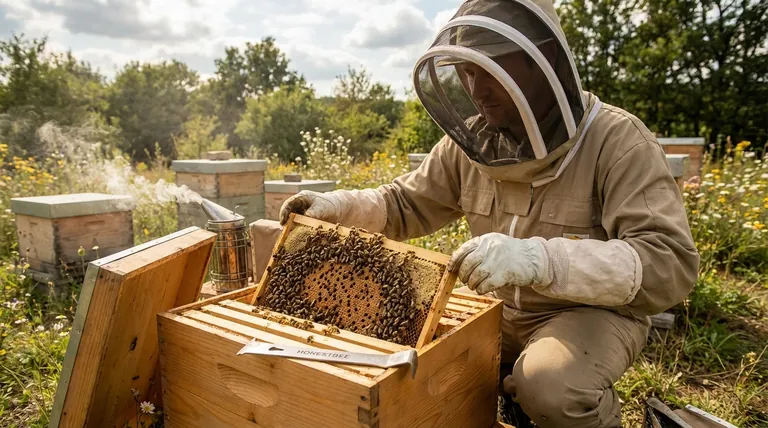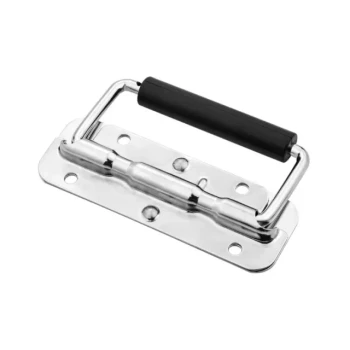At its core, beekeeping is proactive stewardship. A beekeeper's primary responsibilities are to manage the hive's physical structure, regulate its immediate environment, and consistently monitor the colony's health. These actions are not just about producing honey; they are about ensuring the long-term survival and vitality of a complex superorganism.
Effective beekeeping isn't a checklist of chores, but a practice of creating a stable, safe, and resource-rich environment for the colony. Your goal is to anticipate the bees' needs and solve problems before they become crises, allowing the hive's natural instincts to flourish.

Managing the Hive's Physical Structure
The hive is the colony's home, fortress, and nursery. Your first duty is to ensure this structure is sound and serves the bees' needs.
Ensuring Structural Integrity
A damaged or poorly maintained hive is a liability. You must regularly inspect for and replace any broken, rotted, or ill-fitting components like boxes, bottom boards, and lids.
Even small gaps can create drafts that stress the colony or create entry points for pests like mice and opportunistic insects.
Installing Essential Components
Proper installations are critical for hive management. This includes a rain cover or telescoping outer cover to protect the hive from weather.
A queen excluder is often used to separate the brood chamber from the honey supers, ensuring the queen only lays eggs in the designated lower boxes. This simplifies honey harvesting.
Maintaining a Clean Foundation
Debris on the hive's bottom board can become a breeding ground for pests like wax moths and small hive beetles. Regular cleaning is a simple but effective pest management strategy.
Regulating the Hive Environment
A colony's success is deeply tied to its immediate surroundings. You must act as an environmental regulator, protecting the hive from external threats.
Providing Proper Ventilation
Moisture is a greater threat to a colony than cold, especially in winter. Proper ventilation is essential to allow moist air to escape the hive.
This prevents mold growth and reduces the spread of disease. It also helps the bees cure nectar into honey more efficiently by lowering the in-hive humidity.
Protecting from the Elements
The hive's location is critical. It should be placed to receive morning sun, which encourages early foraging, but may need afternoon shade in hot climates to prevent overheating.
A windbreak is crucial in colder regions to reduce the windchill factor and help the colony conserve energy and heat during winter.
Ensuring Access to Resources
While bees are excellent foragers, they can face periods of "dearth" when few plants are blooming. A key responsibility is to monitor their food stores—honey and pollen.
If stores are low, you must provide supplemental feeding, such as sugar syrup or pollen patties, to prevent the colony from starving.
The Critical Task of Hive Inspection
Regular inspection is how you "read" the hive and diagnose its condition. This is the most skill-intensive responsibility of a beekeeper.
Reading the Brood Pattern
The queen's laying pattern is a primary indicator of hive health. A healthy queen lays eggs in a tight, consolidated pattern.
A spotty or scattered brood pattern can indicate a failing queen, disease, or other systemic problems within the colony.
Scouting for Pests and Diseases
This is arguably the most important task in modern beekeeping. You must be vigilant in monitoring for the Varroa destructor mite, the single greatest threat to honey bees worldwide.
Regular mite counts and timely treatments are non-negotiable. You also need to learn to identify other issues like American Foulbrood, chalkbrood, and hive beetles.
Assessing Population and Temperament
A strong, growing population is a sign of a healthy hive. A sudden drop in population is a clear warning sign that requires immediate investigation.
Likewise, a sudden shift in the colony's temperament from calm to highly defensive can signal that the hive has become queenless or is under significant stress.
Understanding the Trade-offs and Pitfalls
Effective beekeeping requires balance. Well-intentioned actions can have negative consequences if not applied thoughtfully.
The Risk of Over-Inspection
Every time you open the hive, you break the propolis seals the bees create to defend their home. This disrupts the colony's temperature and humidity regulation and causes stress.
Inspecting too frequently (more than once every 7-10 days) can do more harm than good, potentially leading to a stressed, less productive colony.
The Danger of Under-Management
The opposite extreme is equally dangerous. A "set it and forget it" approach will almost certainly lead to the colony's demise from Varroa mites, starvation, or swarming.
Benign neglect is not a viable strategy. You must intervene to manage pests and ensure the colony has the resources it needs to survive.
Misinterpreting Queenlessness
New beekeepers often panic when they can't visually find the queen during an inspection. This is a common pitfall.
The queen can be elusive. Instead of searching for her, learn to search for evidence of a queen: freshly laid eggs (tiny rice-like specks, one per cell) and young larvae.
Making the Right Choice for Your Goal
Your specific actions will be guided by what you want to achieve with your bees.
- If your primary focus is pollination: You will prioritize swarm prevention and maintaining a large, healthy population leading into the flowering season.
- If your primary focus is honey production: You will concentrate on diligent pest management and providing ample space (honey supers) at the right time for nectar storage.
- If your primary focus is colony survival and learning: You will focus intensely on regular, gentle inspections and mastering the identification and treatment of pests and diseases above all else.
Ultimately, successful beekeeping is a partnership built on observation, timely intervention, and a deep respect for the colony's natural lifecycle.
Summary Table:
| Responsibility | Key Actions | Why It's Important |
|---|---|---|
| Hive Structure | Inspect & repair components; install covers & excluders; clean bottom boards. | Provides a safe, secure home and simplifies management. |
| Hive Environment | Ensure ventilation; protect from elements; monitor & supplement food stores. | Prevents disease, reduces stress, and prevents starvation. |
| Hive Inspection | Read brood patterns; scout for pests/diseases; assess population & temperament. | Early detection of issues like Varroa mites is critical for survival. |
Equip yourself for success with HONESTBEE.
Effective beekeeping requires reliable, high-quality equipment. At HONESTBEE, we supply the durable beekeeping supplies and essential gear that commercial apiaries and distributors trust to maintain healthy, productive hives. From hive components to pest management tools, our wholesale-focused operations ensure you get the equipment you need to excel in your stewardship.
Contact HONESTBEE today to discuss your supply needs and strengthen your apiary's foundation.
Visual Guide

Related Products
- HONESTBEE Advanced Ergonomic Stainless Steel Hive Tool for Beekeeping
- Professional Multi-Function Stainless Steel Hive Tool
- Professional Dual-End Stainless Steel Hive Tool for Beekeeping
- Professional Drop-Style Hive Handles for Beekeeping
- Professional Grade Foldable Beehive Handles
People Also Ask
- What is a hive tool and what are its uses? Master Your Hive Inspections with the Essential Beekeeper's Tool
- What are the basic tools for beekeeping? Essential Starter Kit for Safe & Successful Hive Management
- What are the features of a regular hive tool? The Essential Multi-Tool for Every Beekeeper
- What are some common uses of a hive tool? Essential Multi-Purpose Tool for Every Beekeeper
- Why is it important to compare the progress of different hives? A Beekeeper's Key Diagnostic Tool



















